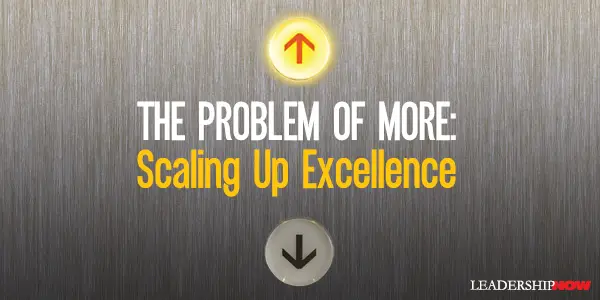 |
 |
02.12.14

The Problem of More: Scaling Up Excellence
HOW DO YOU scale up excellence? How do you spread constructive beliefs and behavior from the few to the many? Bob Sutton and Huggy Rao tackle these questions in Scaling Up Excellence. What they found is that it simply isn’t a matter of just running up the numbers by replicating the same old magic again and again. In fact, they write, “Scaling well hinges on making the right trade-offs between mandating that new people and places become perfect clones of some original model versus encouraging local variation, experimentation, and customization. Something they refer to as the Catholic approach versus the Buddhist approach.Scaling up The process requires the mindset of a marathon. It’s like building a bridge as you walk on it. It requires faith and perseverance. Scaling is akin to running a long race where you don’t know the right path, often what seems like the right path turns out to be the wrong one, and you don’t know how long the race will last, where or how it will end, or where the finish line is located….[And yet] plenty of people and teams find ways to master this mess, take satisfaction in their daily accomplishments, and take pride in spreading constructive beliefs and behaviors far and wide. The book is centered on seven mantras of scaling up excellence. They serve as signals as to whether your scaling is going well or badly. Here are the mantras and how Sutton and Rao define them: Spread a Mindset, Not Just a Footprint
Engage All the Senses
Link Short-Term Realities to Long-Term Dreams
Accelerate Accountability
When scaling goes bad, three elements are usually present: Illusion, Impatience, and Incompetence. Decision makers think this is going to be far easier than the facts warrant; they are quick to rush the rollout thinking that when they are ready everyone is ready; and they frankly don’t know what they are doing. A related hallmark is that decision-makers don’t recognize when they are on the verge of subjecting victims (and themselves) to overwhelming mental load, distress, and turmoil. Scaling Requires Both Addition and Subtraction
Slow Down to Scale Faster—and Better—Down the Road
A few other thoughts to consider when considering a scaling an idea or initiative is to conduct a premortem. Ask participants to imagine that it is a year from now. What success or failure has occurred? Was it a good idea? Are we happy living in the world we’ve built? “Looking back from the future helps people bridge short-term and long-term thinking—a hallmark of successful scaling.” While excitement may be there in the beginning, it will soon wear off if steps are not taken to live it. “Although creating enthusiasm and spreading awareness about new beliefs, behaviors, and initiatives are useful first steps for mobilizing a mindset, they aren’t enough. People have to live it or it won’t stick.” Along the way, you need to continue to evaluate your beliefs and mindsets. “You should never stop asking whether the time is ripe to cast them aside.” As part of this approach, it is important to remember that “although more roles and processes are needed as organizations and projects expand, skilled leaders wield their power to eliminate needless friction and complexity—not burden employees with ‘rules, tools and fools’ that make it tougher to do their jobs and waste money and talent.” While scaling is often thought of in terms of growing a company, it is also about spreading an idea. Scaling Up Excellence is an excellent guide on both counts.

Posted by Michael McKinney at 10:48 PM
|
BUILD YOUR KNOWLEDGE
 

How to Do Your Start-Up Right STRAIGHT TALK FOR START-UPS 
Grow Your Leadership Skills NEW AND UPCOMING LEADERSHIP BOOKS 
Leadership Minute BITE-SIZE CONCEPTS YOU CAN CHEW ON 
Classic Leadership Books BOOKS TO READ BEFORE YOU LEAD |